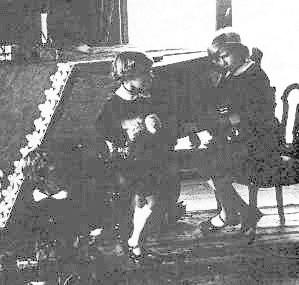

Seasonal Holliday Attire: Christmas Outfits
Children have traditionally dressed up for Christmas events, or probably more correctly mums insist that they dress up. Special dressy outfits are often brought for Christmas. This tradition has declined, but not disappeared. We have little information on historic periods. Many of these outfits in the 19th and most of the 20th century were dressy outfits, often suits for the boys and formal dresses for the girls. In the late 20th century Christmas outfits have become increasingly more casual. Christmas in Europe and North America is commonly associated with cold weatherwear. This is of course not the case for countries in the southern hemisphere--although their traditions come largely from northern hemoisphere countries.
Chronology
Children have traditionally dressed up for Christmas events, or probably more correctly mums insist that they dress up. Special dressy outfits are often brought for Christmas. These of course have varied over times as fashions changed. This tradition has declined, but not disappeared. We have little information on historic periods. Many of these outfits in the 19th and most of the 20th century were dressy outfits, often suits for the boys and formal dresses for the girls. In the late 20th century Christmas outfits have become increasingly more casual. We have begun to collect some information on outfits boys have worn for Christmas in different periods.
Early 19th Century
We have at this time very little information about Christmas outfits in the early 19th century. Christmas outfits were limited to the affluent. Many boys had very limited clothing, some little more than what they wore. Affluent families did have the ability to dress up for fesive occassions. Boys in the early 19th century probably dressed up in their best skeleton suits with ruffled open collars and long pants. Boys also wore tunics, the younger ones with pantalettes and the older ones with trousers.
Mid-19th Century
I am not sure how boys dressed for Christmas at mid-century. Many of our Christmas traditiions, however,, date from the Victorian era. Thus it was during this period that many of our modern Christmas traditions were taking shape. It was thus this period that Christmas trees became popular in America and Britain. Previously it had been more of a
German tradition. I have little real information on Christmas at mid-century. The
clothes worn by boys at mid-century, however, were generally rather plain. Boys commonly wore small collars and bows. Short hair was common as were long pants. The fancy styles worn at Christmas later in the century were not common at mid century.

Figure 5.--This American boy about the turn of the Century poses
in front of his Christmas tree in his knickers sailor suit. He holds
the violin he has just received for Christmas. The rather scragly
Christmas tree suggests a family of modest means, but the violin
would have been a rather significant gift.
|
|
Late 19th Century
Many boys in the late 19th Century might attend Christmas events in fancy dresses if they were not yet breeched. Older boys might wear a kilt or Fauntleroy suit with a frilly lace collar. Other boys might wear plainer suits, but by the 1870s mostly with kneepants. Sailor suits by the 1890s were also common Christmas attire. Kilts were also worn. Some boys from less affluent families might
not have a fancy Fauntleroy suit, but boys from a wide range of economic levels had sailor suits.
Early 20th Century
Boys still wore fancy velvet Fauntleroy suits at the turn of the Century, but by the 1910s, lace collars had been replaced with ruffled collars and the blouses were much plainer than before. Sailor suits were still commonly worn. Knickers had begun to replace kneepants. Black long stockings were normally worn when dressing up. Some boys wore white long stockings, but black was much more common. Major changes occured in boys clothes and thus Christmas attire after World War I (1914-18). It is interesting to speculate as to just why styles changed so radically after the War, but major changes in fashion are not uncommon after such major
war and social upheaval. The fashion of dressing young boys in dresseses disappeared. The fancy Fauntleroy suits disappeared. Sailor suits were still worn by younger boys. Boys began to wear modern looking suits, but with short pants in Europe and knickers in America.

Figure 6.--These three brothers are dressed for a formal traditional
Christmas celebration in the 1970s. The boys wear velvert suits with Peter Pan collars,
shortbpants, white kneesocks and strap shoes.
|
|
Mid-20th Century
A younger boys' party suit by the 1930s was increasiny likely to be an Eton suit rather than a fancy Fauuntleroy suit. Most winter Eton suits were made in flannel, usually grey, navy blue, or black. Fancy Christmas Eton suits, however, were made in black or deep blue velvet. Women's magazines at mid-century, especially from the 1950s-70s commonly showed Christmas scenes og boys in velvet Eton suits. I'm not sure just how commonly they were worn, but they probably were fairly common with affluent families. The suits always had rather short suspender shorts and were mostly commonly worn with at first Eton collars and then blouses with Eton collars and then blouses with Peter Pan collars. The outfits were both with and without ties. Here there was a social class variation. The classic style preferred by upper-class and upper-middle class families was to have the boys wear their collars closed, but without ties. More modest income families copying the classic look often added a tie--almost always a bowtie. The velvet Eton suits were often worn with white kneesocks to give a forma, festive look. Older American boys might wear blue balazers with grey long or, in wealthier families, perhaps short pants. For winter wear kneesocks were still worn. Short
pants even for dressy holiday wear by the 1960s were becoming increasingly less common,
less common, except for the younger boys wearing Eton suits.
Children dressing up formally for Christmas declined in the late-20th century. This ws especially true for boys and girls often enjoyed dressing up. Some parents did insist on their boys dressing up for the holidays. Fancy Christmas wear for boys in the late 20th Century was less commonly short pants.
Some boys still worn velvet Eton suits with short pants, but the shorts were much
longer. Even more common was to wear velvet jackets with knickers. Boys of school age wear long pants suits or the ever popular blue blazer and grey slacks. By the 1990s the Christmas atire even for family gathering or even Church became increasingly more casual, as more and more boys objected to dressing up in coat and ties. Some families still insist that the children dress up for some events, but the number of such families declined substantially.
Christmas in Europe and North America is commonly associated with cold weatherwear. This is of course not the case for countries in the southern hemisphere--although their traditions come largely from northern hemisphere countries. This includes countries like Australia and New Zealand with largely European populations as well as South America. It also includes Americans liviung in southern areas and especially Hawaii.
HBC

Navigate the Boys' Historical Clothing Web holiday pages:
[Return to the Main Christmas page]
[Return to the Main holiday page]
[New Years]
[Valetine Day]
[St. Patrick's Day]
[Easter]
[Fourth of July]
[Haloween]
[Thanksgiving]
Navigate the Boys' Historical Clothing Web Site:
[Introduction]
[Activities]
[Biographies]
[Chronology]
[Clothing styles]
[Countries]
[Essays]
[Literary]
[Topics]
[Bibliographies]
[Contributions]
[FAQs]
[Glossaries]
[Satellite sites]
[Tools]
[Boys' Clothing Home]
Created: December 27, 1998
Last updated: 1:14 PM 12/25/2004





